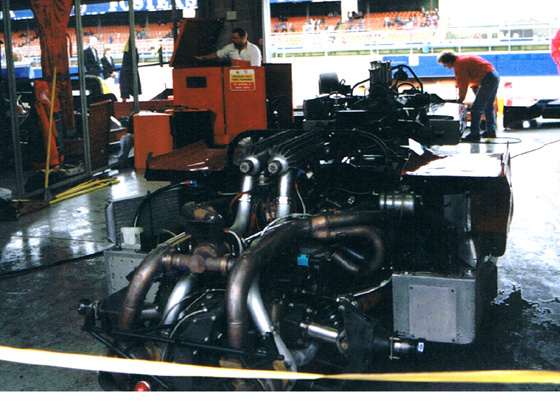-
Administrator

Team VDS Twin-Turbo McLaren M8F

When Mark Donohue lined his new white L&M sponsored Penske Porsche 917/10 on pole at the opening round of the 1972 Can-Am championship ahead of the Gulf McLaren M20s of Peter Revson and Denny Hulme, there was a clear sense of a changing of the guard in big-bore sports car racing. After five years of domination by the McLaren team, Donohue whistled away from the rolling start, and despite Revson getting the jump, the big white Porsche was in front by the first turn, and proceeded to drive away comfortably until he was forced to pit with a jammed throttle linkage which delayed him for three laps. But it was clear, turbo-charging had arrived.
Donohue didn’t win the ’72 Can-Am, but his car did. After spending much of 1971 based in Germany at the Porsche factory, burying himself into the role of development and testing, Donohue and the Porsche engineers sculpted the 917/10 into a formidable racing machine. After his strong opening round showing, Donohue injured himself badly in a testing shunt, and George Follmer took over driving duties of the Penske turbo Panzer, winning the Can-Am championship, despite missing the first round. The 917/10 was producing 880hp from its turbo 5 litre 12 cylinder motor by the end of the ’72 Can-Am season, well up on the normally aspirated big block Chevy’s fitted into the back of the works McLarens.
Meanwhile, over in Europe, and due to the huge success the Can-Am enjoyed from its inception in 1966, a similar series was formed in 1970, called Interserie. Given most Can-Am cars were built in the UK by Eric Broadley’s Lola company and by Peter Agg’s Trojan company, which built the customer Mclarens, it made sense that a European big bore sports car series should also enjoy some success. It combined FIA Group 5, 6, and Group 7, under which Can-Am was run in the US. The Interserie would be dominated by Porsche, who cornered the marked in the first couple of years with normally aspirated 917 models, while grids were bolstered by Lola T70 coupes, and smaller Chevron and Lola cars, and a smattering of privateer Group 7 machinery.
Wealthy Belgian racing enthusiast, Count Van der Straeten, entered the Interserie in 1970, running a Lola T70, decked out in the Count’s dark red, with white and blue center stripe racing colours, and with his long time driver Teddy Pilette at the helm. For the ’71 Interserie, Team VDS was armed with a customer McLaren M8E, fitted with a Louis Morand built 7.5 litre alloy big block Chevy, and it was Morand who would develop one of these units, fitted with a pair of exhaust driven Garrett AiResearch turbochargers. After considerable development, the twin-turbo Chevy, boasting an impressive 860hp, was bolted into the rear of the Team VDS M8E, for the opening round of the 1972 Interserie at Imola.
Unlike the Porsche 917/10, of which the entire car and its aerodynamics had been developed around the motor, the Team VDS turbo McLaren was much more a case of simply bolting a blown Chevy into the back of a chassis designed for a normally aspirated motor. Despite the M8E being replaced with a new M8F McLaren early in the ’72 season, the Team VDS machine would finish just one race throughout 1972 and ’73, and prove barely capable of even beating the normally aspirated sister car of Helmuth Kelleners, and neither machine had an answer for Leo Kinnunens 917/10. Pilette must have had frazzled nerves by the end of the second season, with the turbo McLaren suffering a spate of alarming failures and spins, and Team VDS moved away from the Interserie to concentrate its efforts in other racing divisions, such as Formula 5000, where it was enjoying far more success.
Years later, I got to see this amazing machine in action, just once, in the early ‘90s, at which time it was owned by Peter Agg, of Trojan, and his son Charlie, who was himself racing a traditional normally aspirated McLaren M8F very successfully in European historic events. By this time, a ground-splitting 1300hp was being extracted from the now 8.5 litre twin-turbo Chevy motor in the ex-Team VDS M8F, but the chronic reliability issues still plagued it. It ran like a dog in practice, with throttle issues, and could barely conjure up 600hp, and was retired early. But it made more of a statement back in the pits, with its rear bodywork removed, and its massive turbo-chargers, intercoolers, and miles accompanying pipe work making for an elaborate sight.
I believe the motor was eventually converted to a normally aspirated unit a couple of years later, and proved both faster and more reliable, if not nearly as interesting or charismatic.
 Posting Permissions
Posting Permissions
- You may not post new threads
- You may not post replies
- You may not post attachments
- You may not edit your posts
-
Forum Rules






 Reply With Quote
Reply With Quote